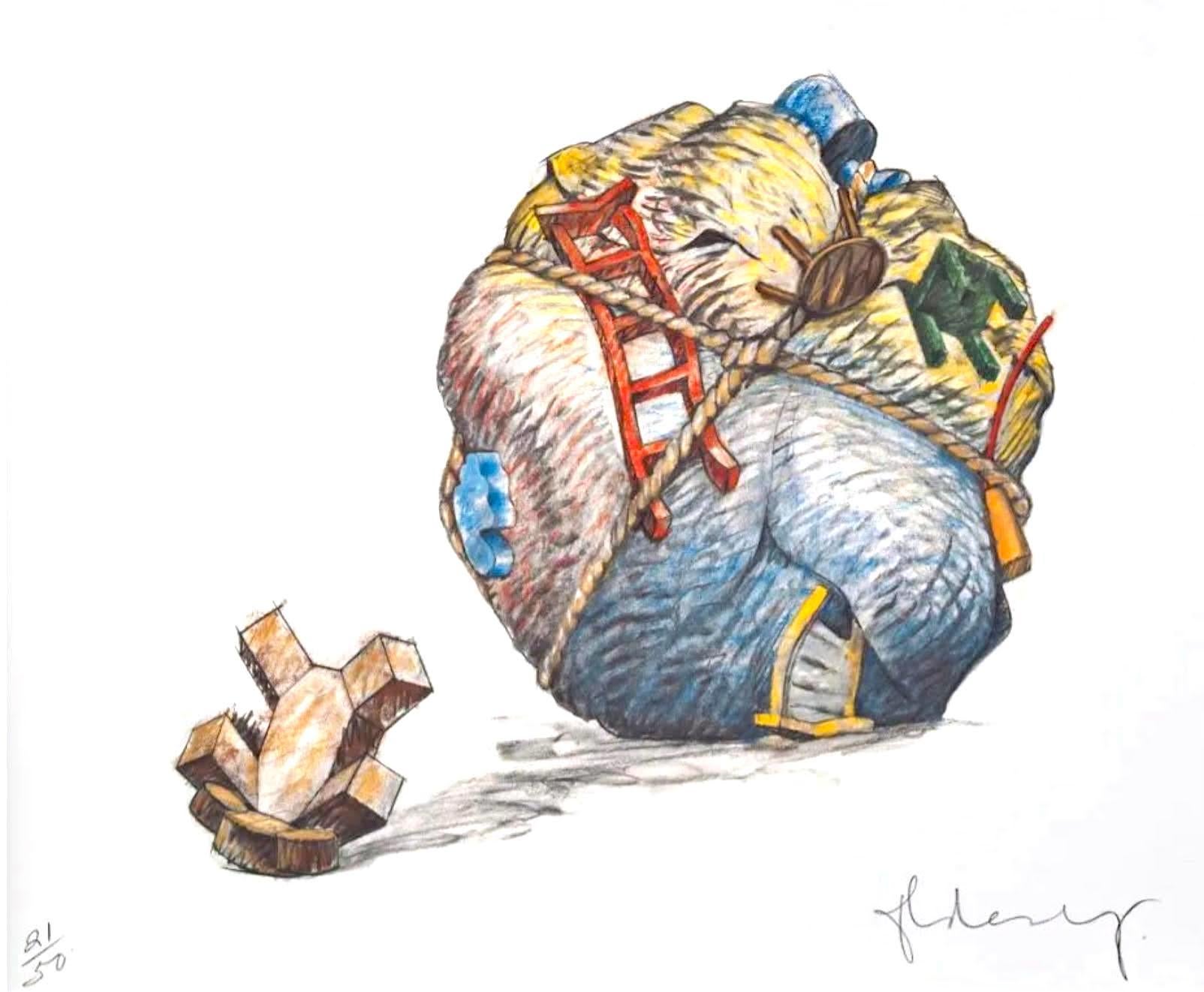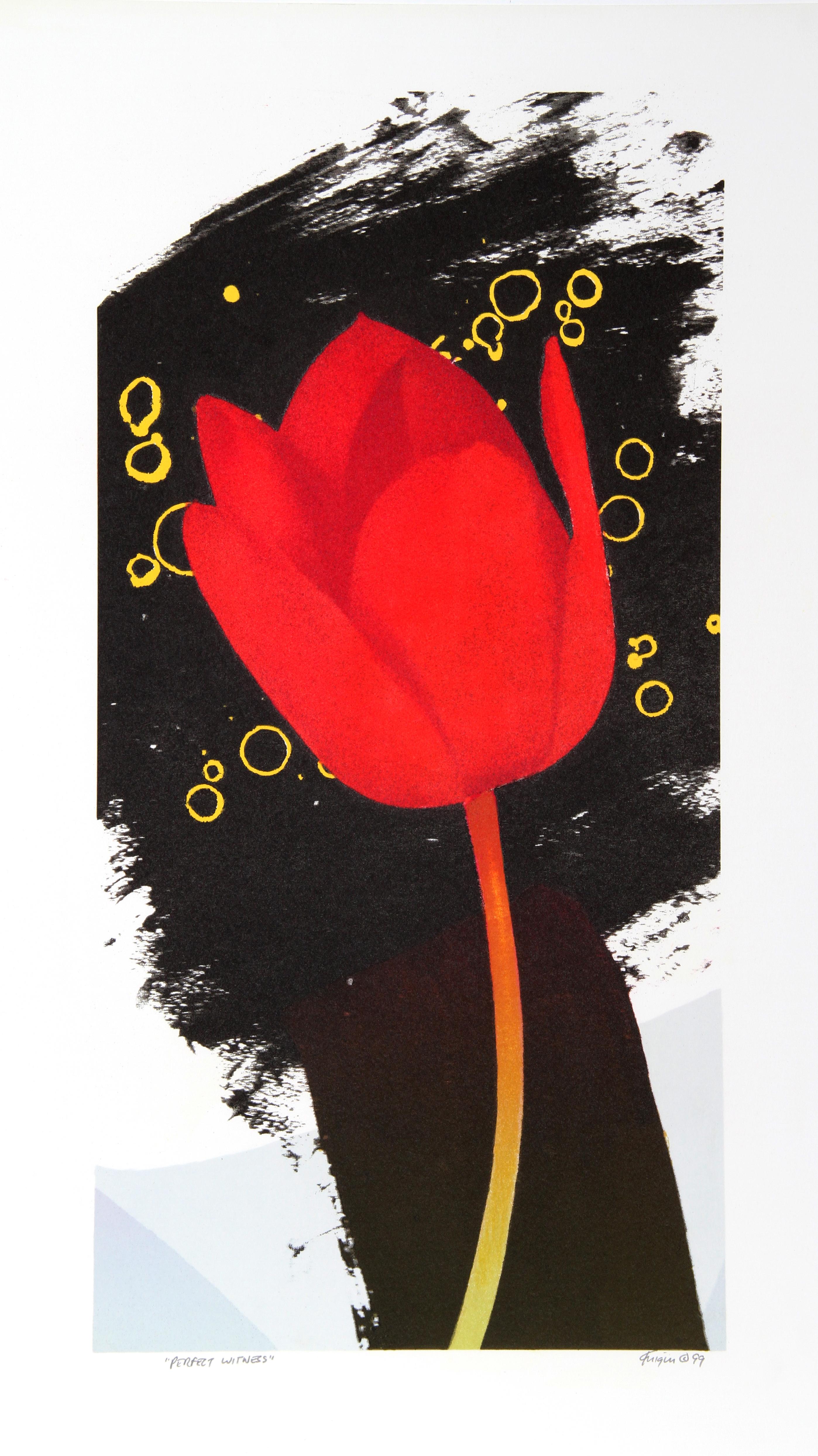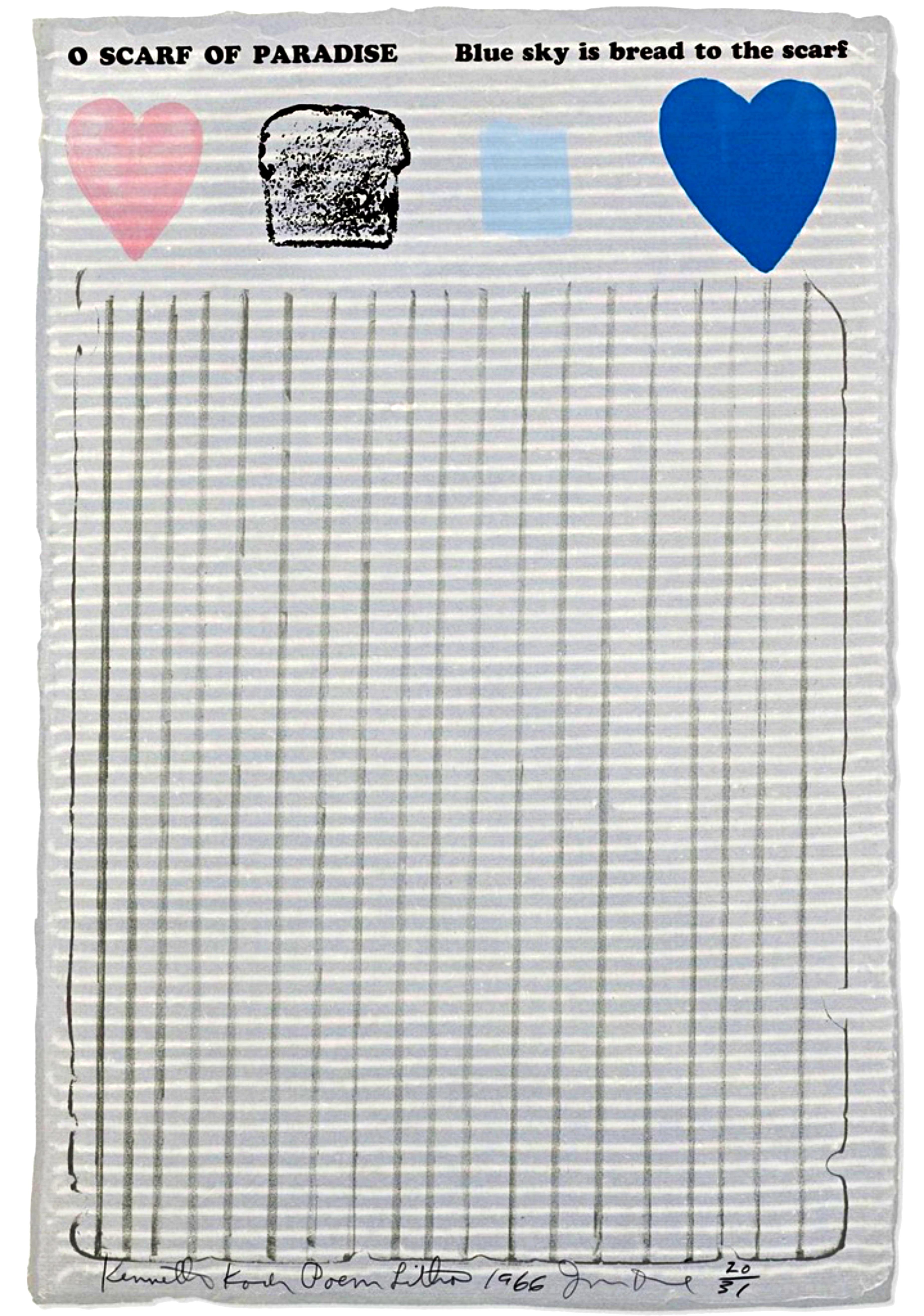Items Similar to "Boldest Native" original lithograph signed pop art abstract hyperrealistic bold
Want more images or videos?
Request additional images or videos from the seller
1 of 8
Michael Knigin"Boldest Native" original lithograph signed pop art abstract hyperrealistic bold1980
1980
About the Item
"Boldest Native" is an original color lithograph by Michael Knigin. This piece features a pile of apples with abstract textures. The artist signed the piece lower right and titled it lower left. This piece is an artist's proof.
Artwork Size: 19" x 19 1/2" art
This piece is unframed. If you would like it framed, our gallery has framing options available. Please leave an inquiry if you would like to discuss framing options.
Artist Bio:
Michael Knigin was born in 1942 in Brooklyn, NY. He attended and graduated from Tyler School of Art, Temple University. During his junior year, he was awarded a Ford Foundation Grant to study fine art lithography at the renowned Tamarind Lithography Workshop, in Los Angeles.
After graduating college in 1966, Knigin started teaching at the Pratt Graphic Center in Manhattan, an extension of the Pratt Institute, devoted to fine arts and graphic prints. There he started a fine art lithography workshop. After a year and a half he opened his own publishing company, Chiron Press, and added a silkscreen printing facility. This was the first facility in the United States that combined lithography and screen-printing. The shop remained in existence for over seven years, printing and publishing editions for the most renowned contemporary artists, including Andy Warhol, Roy Lichtenstein, and Paul Jenkins. In 1970 and 1971 he co-authored two books on lithography, which were published by Van Nostrand/Reinhold. One of these books was a textbook on fine art lithography and was used extensively in schools in the United States and Britain. After selling Chiron Press in 1974, Knigin was invited by the Israel Museum and the Jerusalem Foundation to establish the first professional lithography workshop in Israel and to train a group of young Israeli artists. While in Israel, he collaborated with the Ministry of Labor and Education, along with nationally and internationally known artists from Israel, the United States and Europe. After his tenure at the graphic center, he returned to New York and preceded to create his own prints and paintings. At that time, Knigin was appointed a Professor at Pratt Institute, where he still teaches. In 1988 he was appointed to the NASA Art Team and was sent to the Kennedy Space Center to visually interpret the launch of the space shuttle Discovery, celebrating NASA's return to space after the Challenger's disaster in 1986. In 1991 he was recalled to interpret the touchdown of the space shuttle Atlantis at Edward's Air Force Base. Along with these honors, he has received many awards including Cleo Award for art direction, a fellowship of the American Film Institute in Los Angeles, an Art and Technology Grant, two Certificates of Merit from the National Society of Illustrators. He has judged seven national and international art shows. From 1978 to the present he has had 17 one-person shows, and has been included in approximately a hundred and twenty group shows here and abroad.
Michael's work is included in over 60 museums and corporate collections, including the Whitney American Museum of Art, Albright-Knox, The Cooper Hewitt Museum, The Portland Museum of Art, The Israel Museum, The Port Authority of NY, Citibank, NASA, U.S. Dept. of State, and the Phillip Morris Collection. His work has been written about in approximately forty articles, featured in publications such as the New York Times, Art in America, and Art News. Last but not least, he has been commissioned to create art by over forty corporations and institutions.
His accomplishments in the art field are significant. His contributions to Israel and The United States are well respected by artists, educators, and collectors alike.
- Creator:Michael Knigin (1942 - 2011, American)
- Creation Year:1980
- Dimensions:Height: 19 in (48.26 cm)Width: 19.5 in (49.53 cm)
- Medium:
- Movement & Style:
- Period:
- Framing:Framing Options Available
- Condition:
- Gallery Location:Milwaukee, WI
- Reference Number:
About the Seller
4.9
Platinum Seller
These expertly vetted sellers are 1stDibs' most experienced sellers and are rated highest by our customers.
Established in 1966
1stDibs seller since 2017
390 sales on 1stDibs
Typical response time: 1 hour
- ShippingRetrieving quote...Ships From: Milwaukee, WI
- Return PolicyA return for this item may be initiated within 14 days of delivery.
More From This SellerView All
- "Morph Dog Fireworks Bouquet, " Original Print on Paper by David BarnettBy David BarnettLocated in Milwaukee, WI"Morph Dog Series: Morph Dog Fireworks Bouquet Vertical Variation" a giclée print of an original watercolor painting by David Barnett. The print is signed in the lower right by the a...Category
2010s Contemporary Still-life Prints
MaterialsArchival Paper, Giclée
- 'Firework Series: Grand Finale I' signed giclée print after 1997 originalBy David BarnettLocated in Milwaukee, WIPart of the artist’s ‘Firework Series,’ ‘Grand Finale I’ is a giclée print after the 1997 original, signed by the artist in the lower left. Pointillistic fireworks bloom over the Sta...Category
Early 2000s Contemporary Still-life Prints
MaterialsGiclée
- 'Ten Commandments' signed giclée print on watercolor paper, still lifeBy David BarnettLocated in Milwaukee, WI‘Ten Commandments’ is a giclée print on watercolor paper, signed by the artist in the lower right. In the composition, Barnett presents a still life of Jewish ritual objects, includi...Category
Early 2000s Contemporary Still-life Prints
MaterialsGiclée
- 'Celebration (Homage to Sharon)' signed artist's proof I/XXV giclée printBy David BarnettLocated in Milwaukee, WI‘Celebration (Homage to Sharon)’ is an artist’s proof giclée print, signed and dated by the artist in the lower right. This piece is a part of Barnett’s ‘Morph Dog Series,’ so named ...Category
Early 2000s Contemporary Still-life Prints
MaterialsGiclée
- 'Flowers' original abstract linocut by Wisconsin artist Schomer LichtnerBy Schomer LichtnerLocated in Milwaukee, WI'Flowers' is an original linocut by Wisconsin-based artist Schomer Lichtner. The composition presents a scattered floral still life amongst abstracted shadows and forms, rendered with Lichtner's quintessential abstract sensibilities. This print is one from a series that each depict abstracted subjects in black silhouette, taking pleasure in the materiality of the linocut technique. The free forms of the flower resemble the lyrical mid-century works of the French artist Henri Matisse, which combined with these material concerns demonstrate Lichter's modern sensibilities. The prints from this series are unusual because of how below the image, Lichtner also includes his Chinese seal and a linocut remarque of a cow, each of which act as an additional signature of the artist on the artwork. Linocut in black and red on Permalife white wove paper 4 x 5.25 inches, image 11.5 x 8.75 inches, sheet 16.5 x 13.63 inches, frame Signed in pencil, below image, lower right. Edition 1/100 in pencil, below image, lower left. Chinese signature stamp in red, below image, lower right. Remaque of a cow in red, below image, lower right. Permalife watermark to paper. Framed to conservation standards in a shadow-box style mounting, using 100 percent rag matting, museum glass, and housed in a silver-finish wood moulding. Overall excellent condition with no creases or discoloration. Milwaukee artist Schomer Lichtner was well known for his whimsical cows and ballerinas and abstract imagery. He and his late wife Ruth Grotenrath, both well-known Wisconsin artists, began their prolific careers as muralists for WPA projects, primarily post offices. Lichtner also painted murals for industry and private clients. Schomer was a printmaker and produced block prints, lithographs, and serigraph prints. His casein (paint made from dairy products) and acrylic paintings are of the rural Wisconsin landscape and farm animals. He became interested in cows when he and Ruth spent summers near Holy Hill in Washington County. According to David Gordon, director of the Milwaukee Art Museum, Schomer Lichtner had a tremendous joie de vivre and expressed it in his art. Schomer Lichtner was nationally known for his whimsical paintings and sculptures of black- and white-patterned Holstein cows...Category
Late 20th Century American Modern Abstract Prints
MaterialsPaper, Black and White, Linocut
- "Back Cover of "Chagall Lithographe III, " M 577, " an Original Color LithographBy Marc ChagallLocated in Milwaukee, WIThis is the back cover of "Chagall Lithographe III," M 577". It is an original Lithograph by Marc Chagall. This print is a glorious black and red bouquet, most of the foliage is shown by black leaves and stems where as the flowers and blooms are red. Also on the top right one can see a tiny red bird. Image: 12.5 x 10 in Frame: 25.5 x 21.5 in Marc Chagall was born in Liozno, near Vitebsk, now in Belarus. The eldest of nine children in a close-knit Jewish family. His father Khatskl (Zakhar) Shagal, a herring merchant, and his mother, Feige-Ite. This period of his life, described as happy though impoverished, appears in references throughout Chagall's work. The family home on Pokrovskaya Street is now the Marc Chagall Museum. He began studying painting in 1906 with a local artist, Yehuda Pen. In 1907, he moved to St. Petersburg. There he joined the school of the Society of Art Supporters and studied under Nikolai Roerich. It was here that he was exposed to experimental theater and the work of such artists as Gauguin. From 1908-1910 Chagall studied under Leon Bakst at the Zvantseva School of Drawing and Painting. This was a difficult period for Chagall; at the time, Jewish residents were only allowed to live in St. Petersburg with a permit, and the artist was jailed for a brief period for an infringement of this restriction. Despite this, Chagall remained in St. Petersburg until 1910, and regularly visited his home town where, in 1909, he met his future wife, Bella Rosenfeld. After gaining a reputation as an artist, Chagall left St. Petersburg to settle in Paris to be near the burgeoning art community in the Montparnasse district, where he developed friendships with such avant-garde luminaries as Guillaume Apollinaire, Robert Delaunay, and Fernand Léger. In 1914, he returned to Vitebsk and, a year later, married his fiancée, Bella. While in Russia, World War I erupted and, in 1916, the Chagalls had their first child, a daughter named Ida. Chagall became an active participant in the Russian Revolution of 1917. Although the Soviet Ministry of Culture made him a Commissar of Art for the Vitebsk region, where he founded Vitebsk Museum of Modern Art and an art school, he did not fare well politically under the Soviet system. "Chagall was considered a non-person by the Soviets because he was Jewish and a painter whose work did not celebrate the heroics of the Soviet people."[6] He and his wife moved back to Paris in 1922. During this period, Chagall wrote articles, poetry and his memoirs (in Yiddish,) which were published mainly in newspapers (and only posthumously in book-form). Chagall became a French citizen in 1937. With the Nazi occupation of France during World War II and the deportation of Jews, the Chagalls fled Paris, seeking asylum at Villa Air-Bel in Marseille, where the American journalist Varian Fry assisted in their escape from France through Spain and Portugal. In 1941, the Chagalls settled in the United States where he lived until 1948 (his wife Bella died in 1944.) His wife Bella, who appears in many of his paintings, bore him one child, Ida and then died on September 2, 1944. Bella and Ida appeared in many of his early and most famous paintings. In 1945, he began a relationship with his housekeeper Virginia Haggard McNeil, with whom he had a son, David. In the 1950s, they moved to a villa in Provence. Virginia left him in 1952, and Chagall married Valentina Brodsky (whom he called "Vava"). Jewish influence: Chagall had a complex relationship with Judaism. On the one hand, he credited his Russian Jewish cultural background as being crucial to his artistic imagination. But however ambivalent he was about his religion, he could not avoid drawing upon his Jewish past for artistic material. As an adult, he was not a practicing Jew, but through his paintings and stained glass, he continually tried to suggest a more "universal message," using both Jewish and Christian themes...Category
1960s Surrealist Still-life Prints
MaterialsLithograph
You May Also Like
- Houseball with Fallen Toy BearBy Claes OldenburgLocated in New York, NYClaes Oldenburg Houseball with Fallen Toy Bear, 2013 Color lithograph on Japanese watercolor paper Hand signed and numbered 21/50 by Claes Oldenburg on the ...Category
2010s Pop Art Still-life Prints
MaterialsLithograph
- Saint Louis Art Museum poster (Hand Signed and dated by Roy Lichtenstein)By Roy LichtensteinLocated in New York, NYRoy Lichtenstein Roy Lichtenstein 1970-1980 (Hand Signed and dated by Roy Lichtenstein), 1981 Offset lithograph. Hand signed and dated in ink Hand-si...Category
1980s Pop Art Abstract Prints
MaterialsOffset, Ballpoint Pen, Lithograph
- Perfect Witness, Pop Art Lithograph by Michael KniginBy Michael KniginLocated in Long Island City, NYPerfect Witness Michael Knigin, American (1942–2011) Date: 1999 Lithograph, Signed and Numbered in Pencil Edition of 80 Size: 30 in. x 22 in. (76.2 cm x 55.88 cm)Category
1990s Pop Art Still-life Prints
MaterialsLithograph
- Homage to Kenneth Koch with Hearts, Bread Sky - Pop Art print showing food, loveBy Jim DineLocated in New York, NYJim Dine Kenneth Koch Homage (Oh Scarf of Paradise, Blue Sky is Bread to the Scarf), 1966 Color lithograph on blue grey wove paper with deckled edges 37 × 24 1/2 inches Pencil signed...Category
1960s Pop Art Abstract Prints
MaterialsLithograph, Pencil
- Vintage Original Poster Sister Corita Kent Lithograph Pop Art "Life Without War"By Mary Corita (Sister Corita) KentLocated in Surfside, FLCorita Kent (American, 1918 - 1986)"We Can Create Life without War" Corita Billboard Peace Project Poster 1985 Corita Billboard Event - Part of Peace Week, January 17-24, 1985 San Lu...Category
1980s Pop Art Abstract Prints
MaterialsLithograph, Screen, Offset
- COSMIC FLOWERS Signed Lithograph, Abstract Floral, Happy Colors, Blue Red YellowBy Peter MaxLocated in Union City, NJCosmic Flowers is an original hand drawn lithograph by Peter Max printed using traditional hand lithography techniques on archival Arches paper, 100% aci...Category
1980s Pop Art Still-life Prints
MaterialsLithograph





